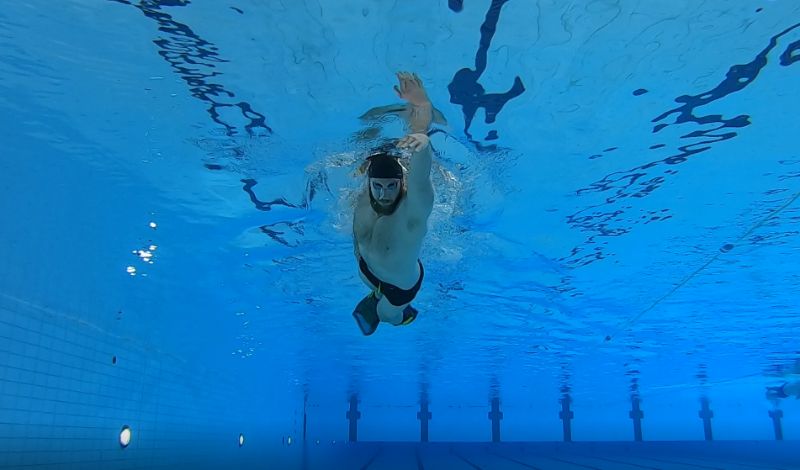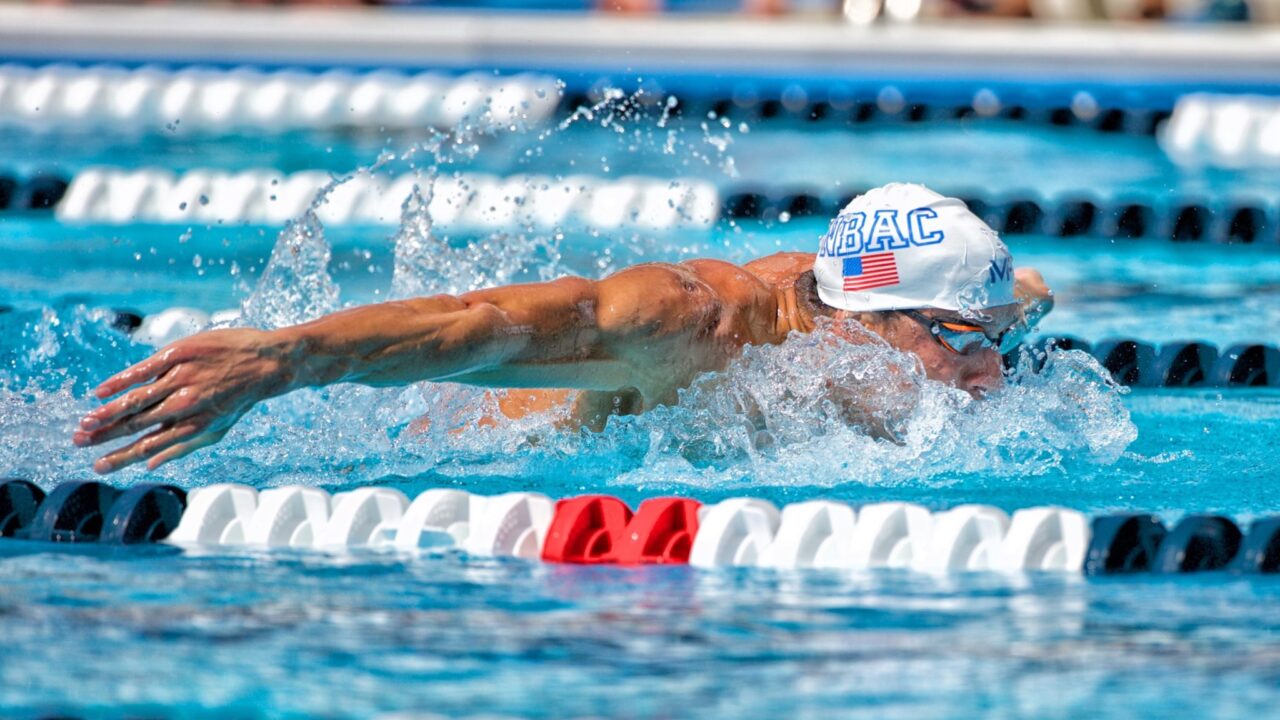Swim fins are one of the essential swimming aids for better technique, increased endurance, and a stronger kick. Here are the benefits of swimming with fins and how they can help you become a stronger swimmer.
Swim training fins are one of the most versatile in the world of swimming and swim equipment.
Swimming with fins helps teach you to swim more efficiently, strengthens the legs, and can help you master better kicking mechanics.
Swimming with fins is also fun—who doesn’t love the increased speed of strapping a set of training fins onto your feet!
In this article on the benefits of swimming with fins, we will examine why you should incorporate fins into your swim workouts.
Let’s dive right in.
Benefits of Swimming with Fins
The benefits of swimming with fins include:
- Stronger kick
- Better kicking mechanics
- Increase ankle flexibility
- Better body position
- A stronger upbeat phase of the kick
- Increased lower body power
- Skills and technique at speed
- Increased exertion
- Reduced shoulder strain
- Workout variety
Next, we will look at each benefit individually and how they can help you get closer to your goal of getting faster in the pool.
Later, we will also examine two disadvantages of relying too much on swimming with fins.
1. Stronger kick
Kicking is one of the more misunderstood aspects of swimming performance.
While it doesn’t directly contribute an overwhelming amount of propulsion—one study found that the upper body generates around 90% of total propulsion in the water—a strong kick does play an important role in maintaining body position, powering underwaters, and helping you finish races strong.
Swim fins help to build a stronger kick by amplifying the amount of water being pushed and moved by the legs.

Image credit: The author
Fins engage the legs more effectively compared to regular swimming, helping to strengthen the muscles that power a fast and efficient kick in the water.
As David Marsh, 7-time NCAA champion and Olympic swim coach notes, “Fast swimmers are fast kickers.”
2. Better kicking mechanics
Swimming with fins encourages a narrower kicking motion that is more efficient compared to the extra-wide scissor kicking many swimmers perform.
A study titled “Effects of paddles and fins on front crawl kinematics, arm stroke efficiency, coordination, and estimated energy cost” with competitive swimmers analyzed the kick amplitude in various conditions, including no equipment, swimming with paddles, and swimming with fins.
The amplitude of the kick when wearing swim fins was significantly less compared to the other conditions, suggesting that swimming fins encourage a more narrow and hydrodynamic kick.
| CONDITION | No equipment | Paddles | Fins |
| KICK AMPLITUDE (M) | 0.34 | 0.35 | 0.29 |
For swimmers who scissor-kick too widely or whose legs dangle behind them, creating needless drag, kicking and swimming with fins can be a good corrective exercise for speed-killing motion in the kick.
3. Increased ankle flexibility
Fast kickers have flexible ankles. Increased range of motion in the ankle allows you to “catch” more water with your feet.
Swim fins can help to increase the range of motion by encouraging a wider range of motion in the ankles.
See also: 8 Essential Stretches for Swimmers
A study done with a group of NCAA Division I swimmers published in the Journal of Strength Conditioning Research analyzed whether ankle flexibility, foot size, and vertical jump power influenced kicking and swimming speed.
Guess what separated the so-so kickers from the fast kickers?
Yup—ankle flexibility.
The swimmers with increased range of motion in the ankles not only kicked faster but, on average, also swam faster.
The added surface area on swim fins encourages more flexing of the ankles, providing a gentle stretching effect that can gradually improve ankle mobility.
4. Better body position
Swimming with fins encourages swimmers to maintain a horizontal body position, crucial for reducing drag in the water, especially at higher speeds.
One of the fun paradoxes of swimming is that the faster you go, the more active drag you (exponentially) create.
Consequently, with increased velocity, you must align the body in a more streamlined position to counteract the extra drag.
To perhaps no one’s surprise, Marinho et al. (2009) demonstrated that a horizontal body position is the most hydrodynamic and efficient, resulting in reduced drag and increased overall speed.
Swimming with fins teaches swimmers the necessity of positioning themselves in the water to minimize drag and enhance their swimming efficiency.
5. Stronger upbeat phase of the kick
When it comes to kicking faster, swimmers focus primarily on the downbeat phase.
This makes sense—it’s at this point that the most force is applied in the kick, water is pushed backward, and a large rotating vortex is created, generating propulsion.
But in the upbeat phase of the kick (the “upkick”), another vortex is also created at the feet during knee flexion. Swimmers “push-off” from these vortices during the kicking motion (Andersen and Sanders, 2018).
For many swimmers, even experienced competitive athletes, it can feel odd and challenging to create an effective upbeat phase.

Image credit: The author
Using swim fins allows you to really “feel” the upbeat motion of the dolphin (and flutter) kicks. The added surface area of the training fins engages the hamstrings and calves and teaches you to catch water with your feet.
The next time you are at the pool, try some 25s and 50s of kick with fins focusing primarily on the upbeat phase to get a sense of how much additional propulsion you can generate from a more rounded kick.
6. Develop a more powerful kick
Want a more powerful kick? Who doesn’t!
Swimming and kicking fins are an excellent way to develop lower body power in the water.
Whether that means doing efforts with fins on (6×25 free swim with fins on 2:00 ALL-OUT, for example), or resisted swimming or kicking with fins (i.e., Tombstone kicking with a board), implementing fins to your power development in the water is a lot of fun.
See also: 5 Swim Workouts and Sets with Fins (for a Stronger Kick and Faster Swimming)
7. Skills and technique at speed
One of my favorite benefits of swimming fins is using them over the course of the season to master specific skills at high speeds, such as breathing over a huge bow wave and doing flip turns at overspeed velocities.
Why is doing this so important for competitive swimmers?
Because for most of the season, our technique and skills are done at below-race-pace speeds.
This means that when we dust off the tech suit, shave down, and dive in feeling like a million bucks, we end up misfiring on flip turns, have to turn our face to the sky to breathe over a huge bow wave, and so on.
Swimming with fins is a way to master these skills so that when it’s time to uncork grease lightning in competition, you can feel confident that you’ll be able to execute your stroke and race plan properly.
8. It’s a challenging workout.
Swimming with fins requires more energy compared to swimming without equipment. Kicking in the water takes a lot of energy, and swimming with fins increases the overall energy cost that the legs have to pay to generate speed.
In the same study mentioned earlier, the test swimmers experienced the highest energy cost when sprinting with swim fins on compared to sprinting with paddles or with no equipment.
If you are in a hurry at the pool, high-intensity swimming with fins is an effective way to get a great swim workout.
See also: 5 Swimming Workouts You Can Do in 30 Minutes or Less
9. Reduced shoulder strain
Swimming with fins is a way to reduce excess strain on the shoulders during long bouts of swim training. Especially when we swim with fins during the non-main set elements of workouts, like warm-up.
For larger folks like myself who need a little more time to warm-up in the pool, completing my swim practice warm-up with fins on gets the blood flowing more effectively (swimming with fins comes with extra energy cost, after all) and also eases my shoulders into the workout.
When you consider how many arm rotations are completed over the course of a swim workout, saving them for the main set is preferable and reduces overall pressure on the shoulders over the course of the swim season.
Plus, using swim fins during my warm-ups help open up my hips and encourage better and longer underwaters.
Win!
10. Variety in training
Swim boredom comes for us all at some point. Doing the same thing at the pool each day can grow tiresome.
Swimming with fins is a great way to spice things up in training. Whether for doing kick/swim sets, sprint efforts, or drilling down on the up kick, fins add a chlorinated spike of variety to the pool.
Using swim gear like fins in the water helps to keep swimmers engaged and motivated as they pursue their goals in the water.
What are the disadvantages of swimming with fins?
Two disadvantages of swimming with fins include the aid becoming a crutch and altering stroke mechanics.
Like any type of swim training equipment, swimming with fins can become a disadvantage once it becomes a crutch to avoid the meat-and-potato work of improvement in the water.
As swimming with fins is fun, and helps us swim faster than regular swimming, it can be tempting to spend most of your time training with those silicone or rubber jet packs on your feet.
Extended use of swim fins can also change your stroke mechanics in a way that does not transfer to regular swimming or is counter-productive to fast swimming.
One study published in Frontiers in Physiology found that swimming with fins increased the entry and catch phase duration compared to regular swimming, exacerbating the gallop or hitch in swimmer’s strokes.
Just like your swim paddles, pull buoy or kickboard, use swim fins strategically and in service of your swimming goals and desired technique.
Wrapping Things Up
Ultimately, swim fins are an awesome swim aid for swimmers of all levels.
From improved power and speed to better kicking technique and body position, swimming with fins provides a unique opportunity to unlock your full aquatic potential.
The next time you are at the pool, keep these benefits in mind and use swimming fins to take your swimming to the next level.
ABOUT OLIVIER POIRIER-LEROY
Olivier Poirier-Leroy is a former national-level swimmer. He’s the author of YourSwimBook, a ten-month logbook for competitive swimmers.
 He’s also the author of the recently published mental training workbook for competitive swimmers, Conquer the Pool: The Swimmer’s Ultimate Guide to a High-Performance Mindset.
He’s also the author of the recently published mental training workbook for competitive swimmers, Conquer the Pool: The Swimmer’s Ultimate Guide to a High-Performance Mindset.
It combines sport psychology research, worksheets, anecdotes, and examples of Olympians past and present to give swimmers everything they need to conquer the mental side of the sport.
Ready to take your mindset to the next level?
Click here to learn more about Conquer the Pool.

I’d love a set of DMC Elite Max or Arena Powerfins but neither offer something for size 51(EU). I have a set of A3 Swift Kick Fins for size 48 and I can cram my feet in them but my feet really start to hurt after 300 meters or so.
Do you have any recommendation on larger sized short fins that are available for regular order?
Also, I’m curious if either of the fins I mentioned above are offered in a custom size, though I imagine it comes at a significant upcharge.
You’ve your own built in fins with feet that size!! 😁
What do you recommend as the fastest most comfortable fins for training?
DMC Elite Max. A bit pricier than most fins but last forever and are incredibly comfortable.
Yep